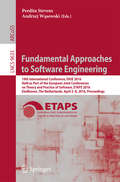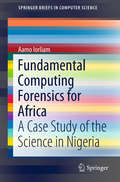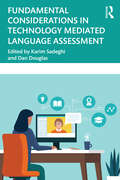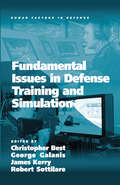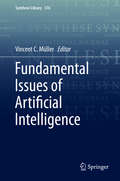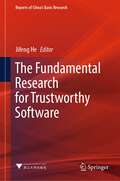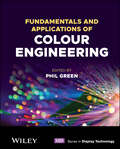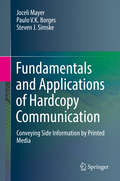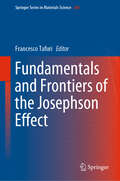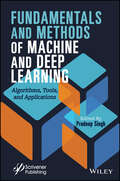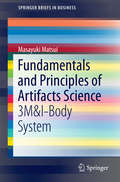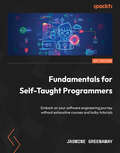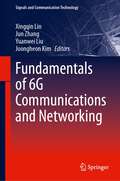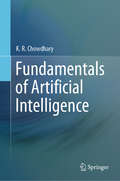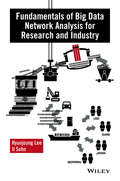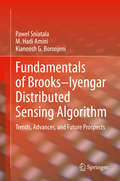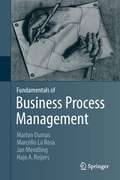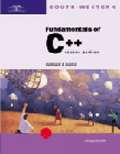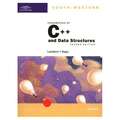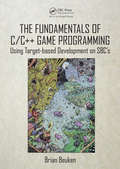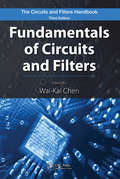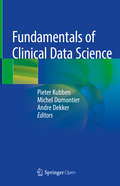- Table View
- List View
Fundamental Approaches to Software Engineering
by Andrzej Wąsowski Perdita StevensThis bookconstitutes the proceedings of the 19th International Conference on FundamentalApproaches to Software Engineering, FASE 2016, which took place in Eindhoven,The Netherlands, in April 2016, held as Part of the European Joint Conferenceson Theory and Practice of Software, ETAPS 2016. The 23 full papers presented in this volume were carefully reviewed and selectedfrom 90 submissions. They were organized in topical sections named: concurrentand distributed systems; model-driven development; analysis and bug triaging;probabilistic and stochastic systems; proof and theorem proving; andverification.
Fundamental Computing Forensics for Africa: A Case Study of the Science in Nigeria (SpringerBriefs in Computer Science)
by Aamo IorliamThis book presents a general introduction to the computational aspects of forensic science, covering the different tools needed for forensic investigations, the importance of forensics and biometrics, and the use of Benford’s law for biometrics and network traffic analysis. It specifically focuses on the application of these techniques in Africa, and how they can be of benefit in the investigation of crime in Nigeria in particular.
Fundamental Considerations in Technology Mediated Language Assessment
by Karim Sadeghi and Dan DouglasFundamental Considerations in Technology Mediated Language Assessment aims to address issues such as how the forced integration of technology into second language assessment has shaped our understanding of key traditional concepts like validity, reliability, washback, authenticity, ethics, fairness, test security, and more. Although computer assisted language testing has been around for more than two decades in the context of high-stakes proficiency testing, much of language testing worldwide has shifted to 'at home' mode, and relies heavily on the mediation of digital technology, making its widespread application in classroom settings in response to the COVID-19 outbreak as unprecedented. Integration of technology into language assessment has brought with it countless affordances and at the same time challenges, both theoretically and practically. One major theoretical consideration requiring attention is the way technology has contributed to a re-conceptualisation of major assessment concepts/constructs. There is very limited literature available on theoretical underpinnings of technology mediated language assessment. This book aims to fill this gap. This book will appeal to academic specialists, practitioners or professionals in the field of language assessment, advanced and/or graduate students, and a range of scholars or professionals in disciplines like educational technology, applied linguistics and TESOL.
Fundamental Issues in Defense Training and Simulation (Human Factors in Defence)
by George Galanis Robert SottilareDefense forces have always invested a great deal of their resources in training. In recent times, changes in the complexity and intensity of operations have reaffirmed the importance of ensuring that warfighters are adequately prepared for the environments in which they are required to work. The emergence of new operational drivers such as asymmetric threats, urban operations, joint and coalition operations and the widespread use of military communications and information technology networks has highlighted the importance of providing warfighters with the competencies required to act in a coordinated, adaptable fashion, and to make effective decisions in environments characterized by large amounts of sometimes ambiguous information. While investment in new technologies can make available new opportunities for action, it is only through effective training that personnel can be made ready to apply their tools in the most decisive and discriminating fashion. There are many factors which can have an impact on the efficacy of training and many issues to consider when designing and implementing training strategies. These issues are often complex and nuanced, and in order to grasp them fully a significant investment of time and energy is required. However, the requirement to respond quickly to ever-changing technology, a high operational tempo and minimal staffing may preclude many in today's defense forces from seeking out all such resources on their own. This edited collection provides brief, easy-to-understand summaries of the key issues in defense training and simulation, as well as guidance for further reading. It consists of a collection of short essays, each of which addresses a fundamental issue in defense training and simulation, and features an up-to-date reference list to enable the reader to undertake further investigation of the issues addressed. In essence, this book provides the optimum starting point, or first resource, for readers to come to terms with the important issues associated with defense training and simulation. The contributions are written by leading scholars from military research institutions in the US, UK, Canada, Australia and New Zealand, as well as selected researchers from academic and private sector research institutions.
Fundamental Issues of Artificial Intelligence
by Vincent C. MüllerThis volume offers a look at the fundamentalissues of present and future AI, especially from cognitive science, computerscience, neuroscience and philosophy. This work examines the conditionsfor artificial intelligence, how these relate to the conditions for intelligencein humans and other natural agents, as well as ethical and societal problemsthat artificial intelligence raises or will raise. The key issues this volume investigates include the relation of AI andcognitive science, ethics of AI and robotics, brain emulation andsimulation, hybrid systems and cyborgs, intelligence and intelligence testing,interactive systems, multi-agent systems, and super intelligence. Based on the 2nd conference on "Theory and Philosophy of ArtificialIntelligence" held in Oxford, the volume includes prominentresearchers within the field from around the world.
Fundamental Issues of Artificial Intelligence (Synthese Library #376)
by Vincent C. MüllerThis volume offers a look at the fundamental issues of present and future AI, especially from cognitive science, computer science, neuroscience and philosophy. This work examines the conditions for artificial intelligence, how these relate to the conditions for intelligence in humans and other natural agents, as well as ethical and societal problems that artificial intelligence raises or will raise. The key issues this volume investigates include the relation of AI and cognitive science, ethics of AI and robotics, brain emulation and simulation, hybrid systems and cyborgs, intelligence and intelligence testing, interactive systems, multi-agent systems, and super intelligence. Based on the 2nd conference on “Theory and Philosophy of Artificial Intelligence” held in Oxford, the volume includes prominent researchers within the field from around the world.
The Fundamental Research for Trustworthy Software (Reports of China’s Basic Research)
by Jifeng HeThis book mainly introduces the research overview, results, and achievements of “The Fundamental Research for Trustworthy Software”, a major research plan of NSFC. The Plan focuses on four key scientific issues:(i) measurement and modeling of software trustworthiness;(ii) construction and verification of trustworthy software;(iii) evolution and control of trustworthy software;(iv) trusted environment construction and evaluation.This book aims to establish a research framework for fundamental research on trustworthy software by focusing on the trustworthiness of embedded software and network application software, as well as the trustworthiness of software in key application fields in China. This book is intended for researchers who have been following the evolution of and trends in the trustworthy software; the book is also a valuable reference resource for practitioners and scholars at various levels and in various fields.
Fundamentals and Applications of Colour Engineering (Wiley Series in Display Technology)
by Phil GreenFUNDAMENTALS AND APPLICATIONS OF COLOUR ENGINEERING EXPERT OVERVIEW OF THE WORLD OF COLOUR ENGINEERING IN THE 21ST CENTURY, WITH NEW, UPDATED TECHNOLOGIES AND A MATLAB TOOLBOX Fundamentals and Applications of Colour Engineering provides important coverage on topics that hold the power to extend our knowledge of colour reproduction, such as colour measurement and appearance and the methods used, with additional discussion of the technologies responsible for reproducing colour across a wide range of devices, together with the colour management systems that are used to connect devices and exchange information. Composed of 20 chapters, the Editor and his team of expert contributors consider the new ICC.2 architecture, an approach that introduces an evolutionary step in colour engineering, ensuring wider possibilities for technology. The text also considers the emerging applications for advanced colour management, such as processing spectral data, handling HDR images, and the capture and reproduction of material appearance. The text is supported by a MATLAB toolbox of relevant functions and data. Fundamentals and Applications of Colour Engineering is a useful reference for anyone involved in the reproduction of colour and a strong supplementary course potential for master???s degrees with a colour science component. Fundamentals and Applications of Colour Engineering includes information on: Instruments and methods of colour measurement, colorimetry, and colour difference, and colour appearance Colour spaces and colour encodings, and characterizing input devices, displays and printers Colour gamut communication and imaging standards, high dynamic range imaging, and HDR Sensor adjustment in colour management, open source tools for colour engineering, and colour transform evaluation Supporting active learning with the inclusion of a toolbox of relevant functions and data, Fundamentals and Applications of Colour Engineering is an essential resource for students in relevant programs of study, and for professionals within colour engineering and reproduction looking to maximize their skill set and keep their skills updated.
Fundamentals and Applications of Hardcopy Communication: Conveying Side Information By Printed Media
by Joceli Mayer Steven J. Simske Paulo V.K. BorgesThis book presents covert, semi-covert and overt techniques for communication over printed media by modifying images, texts or barcodes within the document. Basic and advanced techniques are discussed aimed to modulate information into images, texts and barcodes.Conveying information over printed media can be useful for content authentication, author copyright, information and piracy product deterrent, side information for marketing, among other applications. Practical issues are discussed and experiments are provided to evaluate competitive approaches for hard-copy communication.This book is a useful resource for researchers, practitioners and graduate students in the field of hard-copy communication by providing the fundamentals, basic and advanced techniques as examples of approaches to address the hard-copy media distortions and particularities.
Fundamentals and Frontiers of the Josephson Effect (Springer Series in Materials Science #286)
by Francesco TafuriThis book provides a comprehensive and up-to-date description of the Josephson effect, a topic of never-ending interest in both fundamental and applied physics. In this volume, world-renowned experts present the unique aspects of the physics of the Josephson effect, resulting from the use of new materials, of hybrid architectures and from the possibility of realizing nanoscale junctions. These new experimental capabilities lead to systems where novel coherent phenomena and transport processes emerge. All this is of great relevance and impact, especially when combined with the didactic approach of the book. The reader will benefit from a general and modern view of coherent phenomena in weakly-coupled superconductors on a macroscopic scale. Topics that have been only recently discussed in specialized papers and in short reviews are described here for the first time and organized in a general framework. An important section of the book is also devoted to applications, with focus on long-term, future applications. In addition to a significant number of illustrations, the book includes numerous tables for comparative studies on technical aspects.
Fundamentals and Methods of Machine and Deep Learning: Algorithms, Tools, and Applications
by Pradeep SinghFUNDAMENTALS AND METHODS OF MACHINE AND DEEP LEARNING The book provides a practical approach by explaining the concepts of machine learning and deep learning algorithms, evaluation of methodology advances, and algorithm demonstrations with applications. Over the past two decades, the field of machine learning and its subfield deep learning have played a main role in software applications development. Also, in recent research studies, they are regarded as one of the disruptive technologies that will transform our future life, business, and the global economy. The recent explosion of digital data in a wide variety of domains, including science, engineering, Internet of Things, biomedical, healthcare, and many business sectors, has declared the era of big data, which cannot be analysed by classical statistics but by the more modern, robust machine learning and deep learning techniques. Since machine learning learns from data rather than by programming hard-coded decision rules, an attempt is being made to use machine learning to make computers that are able to solve problems like human experts in the field. The goal of this book is to present a??practical approach by explaining the concepts of machine learning and deep learning algorithms with applications. Supervised machine learning algorithms, ensemble machine learning algorithms, feature selection, deep learning techniques, and their applications are discussed. Also included in the eighteen chapters is unique information which provides a clear understanding of concepts by using algorithms and case studies illustrated with applications of machine learning and deep learning in different domains, including disease prediction, software defect prediction, online television analysis, medical image processing, etc. Each of the chapters briefly described below provides both a chosen approach and its implementation. Audience Researchers and engineers in artificial intelligence, computer scientists as well as software developers.
Fundamentals and Principles of Artifacts Science
by Masayuki MatsuiThis is the first book covering original information on the mathematical science of such the artifacts as 3M&I-body system, in which "3M" means human, material/machine, money, and "I" means the information/method in nature versus artifacts. This book is the product of industrial engineering versus Wiener's cybernetics challenge for a half-century. For 3M&I-body, there are two approaches of artificial intelligence/IoT (internet of things) and Matsui's matrix/3D to systemization and control. The former is the analogical and visual approach to real entity. The latter is the digital and logical approach to system decision and is applied to the robotics of bodies. The mathematical science of a body is well constructed from the algebra, geometry, analysis, and control on Matsui's equation, toward the sandwich and balancing propositions of bodies. The sandwich issues propose the squeeze or pinching theorem in mathematics at the 3M&I-body, and the balancing issues propose the principle of balancing and invisible collaboration of bodies, beginning from the work of Archimedes. This book contributes to the integration of knowledge and intelligence in science and facilitate the realization of the cyber/real-world , such as the enterprise robot, cloud-coordinated supply-chain management (SCM), and smart cities in the near future.
Fundamentals for Self-Taught Programmers: Embark on your software engineering journey without exhaustive courses and bulky tutorials
by Jasmine GreenawayAn absolute beginner's guide to strengthening the fundamentals before learning your first programming languagePurchase of the print or Kindle book includes a free PDF eBookKey FeaturesExplore fundamental computer science concepts from data structures through to object-oriented programmingProgress from understanding the software engineering landscape to writing your first programAuthored by a Microsoft community insider and filled with case studies from software engineering rolesBook DescriptionSoftware engineering is a set of techniques, including programming, within the computer science discipline associated with the development of software products. This practical guide to software engineering will enable aspiring and new developers to satisfy their curiosity about the industry and become ready to learn more about the basics before beginning to explore programming languages, along with helping junior and upcoming developers to effectively apply their knowledge in the field. The book begins by providing you with a comprehensive introduction to software engineering, helping you gain a clear, holistic understanding of its various sub-fields. As you advance, you'll get to grips with the fundamentals of software engineering, such as flow control, data structures and algorithms. The book also introduces you to C# and guides you in writing your first program. The concluding chapters will cover case studies, including people working in the industry in different engineering roles, as well as interview tips and tricks and coding best practices. By the end of this programming book, you'll have gained practical knowledge of the implementation and associated methodologies in programming that will have you up and running and productive in no time.What you will learnGain an understanding of the software engineering landscapeGet up and running with fundamental programming concepts in C#Implement object-oriented programming (OOP) in C#Gain insights on how to keep the code readable and reusableDiscover various tips and tricks to efficiently prepare for a software engineering interviewImplement various popular algorithms using C#Who this book is forThis book is for anyone who is curious about programming and interested in entering the field of software engineering by beginning at the fundamentals. No prior knowledge of computer science or software engineering is necessary.
Fundamentals in Assistive Technology 4th Edition
by Michelle L. LangeAn Introduction to Assistive Technology Implementation in the Lives of People with Disabilities
Fundamentals of 6G Communications and Networking (Signals and Communication Technology)
by Xingqin Lin Jun Zhang Yuanwei Liu Joongheon KimThis book begins with a historical overview of the evolution of mobile technologies and addresses two key questions: why do we need 6G? and what will 6G be? The remaining chapters of this book are organized into three parts: Part I covers the foundation of an end-to-end 6G system by presenting 6G vision, driving forces, key performance indicators, and societal requirements on digital inclusion, sustainability, and intelligence. Part II presents key radio technology components for the 6G communications to deliver extreme performance, including new radio access technologies at high frequencies, joint communications and sensing, AI-driven air interface, among others. Part III describes key enablers for intelligent 6G networking, including network disaggregation, edge computing, data-driven management and orchestration, network security and trustworthiness, among others. This book is relevant to researchers, professionals, and academics working in 5G/6G and beyond.
Fundamentals of Artificial Intelligence
by K.R. ChowdharyFundamentals of Artificial Intelligence introduces the foundations of present day AI and provides coverage to recent developments in AI such as Constraint Satisfaction Problems, Adversarial Search and Game Theory, Statistical Learning Theory, Automated Planning, Intelligent Agents, Information Retrieval, Natural Language & Speech Processing, and Machine Vision. The book features a wealth of examples and illustrations, and practical approaches along with the theoretical concepts. It covers all major areas of AI in the domain of recent developments. The book is intended primarily for students who major in computer science at undergraduate and graduate level but will also be of interest as a foundation to researchers in the area of AI.
Fundamentals of Big Data Network Analysis for Research and Industry
by Hyunjoung Lee Il SohnFundamentals of Big Data Network Analysis for Research and Industry Hyunjoung Lee, Institute of Green Technology, Yonsei University, Republic of Korea Il Sohn, Material Science and Engineering, Yonsei University, Republic of Korea Presents the methodology of big data analysis using examples from research and industry There are large amounts of data everywhere, and the ability to pick out crucial information is increasingly important. Contrary to popular belief, not all information is useful; big data network analysis assumes that data is not only large, but also meaningful, and this book focuses on the fundamental techniques required to extract essential information from vast datasets. Featuring case studies drawn largely from the iron and steel industries, this book offers practical guidance which will enable readers to easily understand big data network analysis. Particular attention is paid to the methodology of network analysis, offering information on the method of data collection, on research design and analysis, and on the interpretation of results. A variety of programs including UCINET, NetMiner, R, NodeXL, and Gephi for network analysis are covered in detail. Fundamentals of Big Data Network Analysis for Research and Industry looks at big data from a fresh perspective, and provides a new approach to data analysis. This book: Explains the basic concepts in understanding big data and filtering meaningful data Presents big data analysis within the networking perspective Features methodology applicable to research and industry Describes in detail the social relationship between big data and its implications Provides insight into identifying patterns and relationships between seemingly unrelated big data Fundamentals of Big Data Network Analysis for Research and Industry will prove a valuable resource for analysts, research engineers, industrial engineers, marketing professionals, and any individuals dealing with accumulated large data whose interest is to analyze and identify potential relationships among data sets.
Fundamentals of Brooks–Iyengar Distributed Sensing Algorithm: Trends, Advances, and Future Prospects
by Kianoosh G. Boroojeni M. Hadi Amini Pawel SniatalaThis book provides a comprehensive analysis of Brooks-Iyengar Distributed Sensing Algorithm, which brings together the power of Byzantine Agreement and sensor fusion in building a fault-tolerant distributed sensor network. The authors analyze its long-term impacts, advances, and future prospects. The book starts by discussing the Brooks-Iyengar algorithm, which has made significant impact since its initial publication in 1996. The authors show how the technique has been applied in many domains such as software reliability, distributed systems and OS development, etc. The book exemplifies how the algorithm has enhanced new real-time features by adding fault-tolerant capabilities for many applications. The authors posit that the Brooks-Iyengar Algorithm will to continue to be used where fault-tolerant solutions are needed in redundancy system scenarios.This book celebrates S.S. Iyengar's accomplishments that led to his 2019 Institute of Electrical and Electronics Engineers' (IEEE) Cybermatics Congress "Test of Time Award" for his work on creating Brooks-Iyengar Algorithm and its impact in advancing modern computing.
Fundamentals of Business Process Management
by Marlon Dumas Marcello La Rosa Jan Mendling Hajo A. ReijersBusiness Process Management (BPM) is the art and science of how work should be performed in an organization in order to ensure consistent outputs and to take advantage of improvement opportunities, e.g. reducing costs, execution times or error rates. Importantly, BPM is not about improving the way individual activities are performed, but rather about managing entire chains of events, activities and decisions that ultimately produce added value for an organization and its customers.This textbook encompasses the entire BPM lifecycle, from process identification to process monitoring, covering along the way process modelling, analysis, redesign and automation. Concepts, methods and tools from business management, computer science and industrial engineering are blended into one comprehensive and inter-disciplinary approach. The presentation is illustrated using the BPMN industry standard defined by the Object Management Group and widely endorsed by practitioners and vendors worldwide. In addition to explaining the relevant conceptual background, the book provides dozens of examples, more than 100 hands-on exercises – many with solutions – as well as numerous suggestions for further reading. The textbook is the result of many years of combined teaching experience of the authors, both at the undergraduate and graduate levels as well as in the context of professional training. Students and professionals from both business management and computer science will benefit from the step-by-step style of the textbook and its focus on fundamental concepts and proven methods. Lecturers will appreciate the class-tested format and the additional teaching material available on the accompanying website fundamentals-of-bpm.org.
Fundamentals of Business Process Management
by Marlon Dumas Hajo A. Reijers Jan Mendling Marcello La RosaBusiness Process Management (BPM) is the art and science of how work should be performed in an organization in order to ensure consistent outputs and to take advantage of improvement opportunities, e.g. reducing costs, execution times or error rates. Importantly, BPM is not about improving the way individual activities are performed, but rather about managing entire chains of events, activities and decisions that ultimately produce added value for an organization and its customers. This textbook encompasses the entire BPM lifecycle, from process identification to process monitoring, covering along the way process modelling, analysis, redesign and automation. Concepts, methods and tools from business management, computer science and industrial engineering are blended into one comprehensive and inter-disciplinary approach. The presentation is illustrated using the BPMN industry standard defined by the Object Management Group and widely endorsed by practitioners and vendors worldwide. In addition to explaining the relevant conceptual background, the book provides dozens of examples, more than 100 hands-on exercises - many with solutions - as well as numerous suggestions for further reading. The textbook is the result of many years of combined teaching experience of the authors, both at the undergraduate and graduate levels as well as in the context of professional training. Students and professionals from both business management and computer science will benefit from the step-by-step style of the textbook and its focus on fundamental concepts and proven methods. Lecturers will appreciate the class-tested format and the additional teaching material available on the accompanying website fundamentals-of-bpm.org.
Fundamentals of C++: Introductory Course (2nd Edition)
by Kenneth Lambert Douglas W. NanceFollowing the success of Fundamentals of C++ by Lambert and Nance, C++ Introductory course is essential for a first course in Computer Science. Completely updated, this text provides in-depth coverage to help students prepare for the AP exam, Exam A. A full introduction to the essential features of C++ is provided and programming techniques are emphasized in the context of interesting and realistic case problems. This text is compatible with C++ compilers from Microsoft, Borland, and Metrowerks.
Fundamentals of C++ and Data Structures, Advanced Course (2nd Edition)
by Kenneth Lambert Thomas NapsFollowing the success of Fundamentals of Program Design and Data Structures by Lambert and Naps, C++ Advanced Course is essential for a second course in Computer Science. Completely updated, this text provides in-depth coverage to help students prepare for the AP exam, Exam AB. A full introduction to the essential features of C++ is provided and programming techniques are emphasized in the context of interesting and realistic case problems. This text is compatible with C++ compilers from Microsoft, Borland, and Metrowerks.
The Fundamentals of C/C++ Game Programming: Using Target-based Development on SBC's
by Brian BeukenThis book is aimed at giving novice coders an understanding of the methods and techniques used in professional games development. Designed to help develop and strengthen problem solving and basic C/C++ skills, it also will help to develop familiarity targeting and using fixed/restricted hardware, which are key skills in console development. It allows the reader to increase their confidence as game programmers by walking them through increasingly involved game concepts, while maintaining the understanding that despite the increased complexity, the core methods remain consistent with the advancement of the technology; the technology only enhances the gaming experience. It also demonstrates underlying principles of game coding in practical step by step ways to increase exposure and confidence in game coding concepts. Key Features: Increases the confidence of new coders by demonstrating how to get things done. Introduces evolving projects to reinforce concepts, both directly and indirectly that the reader will use to produce and then enhance the project. Provides tutorials on Graphics API’s that can be easily understood by a novice. Demystifies hardware used to gain new effects without blinding the user to the technical wizardry going on under the system. Gives a sense of achievement to the reader and pushes them toward improvement.
Fundamentals of Circuits and Filters (The Circuits and Filters Handbook, 3rd Edition)
by Wai-Kai ChenThis volume, drawn from the Circuits and Filters Handbook, focuses on mathematics basics; circuit elements, devices, and their models; and linear circuit analysis. It examines Laplace transformation, Fourier methods for signal analysis and processing, z-transform, and wavelet transforms. It also explores network laws and theorems, terminal and port represetnation, analysis in the frequency domain, and more.
Fundamentals of Clinical Data Science
by Pieter Kubben Michel Dumontier Andre DekkerThis open access book comprehensively covers the fundamentals of clinical data science, focusing on data collection, modelling and clinical applications. Topics covered in the first section on data collection include: data sources, data at scale (big data), data stewardship (FAIR data) and related privacy concerns. Aspects of predictive modelling using techniques such as classification, regression or clustering, and prediction model validation will be covered in the second section. The third section covers aspects of (mobile) clinical decision support systems, operational excellence and value-based healthcare. Fundamentals of Clinical Data Science is an essential resource for healthcare professionals and IT consultants intending to develop and refine their skills in personalized medicine, using solutions based on large datasets from electronic health records or telemonitoring programmes. The book’s promise is “no math, no code”and will explain the topics in a style that is optimized for a healthcare audience.
